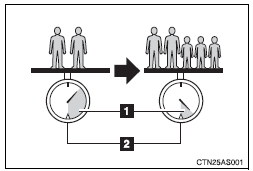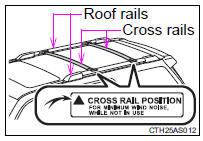Toyota 4Runner: Calculation formula for your vehicle

1. Cargo capacity
2. Total load capacity (vehicle capacity weight)
When 2 people with the combined weight of A lb. (kg) are riding in your vehicle, which has a total load capacity (vehicle capacity weight) of B lb. (kg), the available amount of cargo and luggage load capacity will be C lb. (kg) as follows:

In this condition, if 3 more passengers with the combined weight of D lb.
(kg) get on, the available cargo and luggage load will be reduced E lb. (kg) as follows:

As shown in the example above, if the number of occupants increases, the cargo and luggage load will be reduced by an amount that equals the increased weight due to the additional occupants. In other words, if an increase in the number of occupants causes an excess of the total load capacity (combined weight of occupants plus cargo and luggage load), you must reduce the cargo and luggage on your vehicle.
When using the roof rails

• To use the roof rails as a roof luggage carrier, you must fit the roof rails with two or more genuine Toyota cross rails or their equivalent.
• When there is no luggage on the roof luggage carrier Toyota recommends that the front and rear cross rails be secured in the positions indicated in the illustration. This may reduce wind noise while driving.
CAUTION
Things that must not be carried in the luggage compartment
The following things may cause a fire if loaded in the luggage compartment:
• Receptacles containing gasoline
• Aerosol cans
CAUTION
Storage precautions
Observe the following precautions.
Failure to do so may result in death or serious injury.
• Stow cargo and luggage in the luggage compartment whenever possible.
• Do not stack cargo and luggage in the luggage compartment higher than the
seatbacks.
Such items may be thrown about and possibly injure people in the vehicle in the event of sudden braking or in an accident.
• Do not place cargo or luggage in or on the following locations as the item may get under the brake or accelerator pedal and prevent the pedals from being depressed properly, block the driver’s vision, or hit the driver or passengers, causing an accident:
• At the feet of the driver
• On the front passenger or rear seats (when stacking items)
• On the instrument panel
• On the dashboard
• Secure all items in the occupant compartment, as they may shift and injure someone in the event of sudden braking, sudden swerving or an accident.
• When you fold down the rear seats, long items should not be placed directly behind the front seats.
• Never allow anyone to ride in the luggage compartment. It is not designed for passengers. They should ride in their seats with their seat belts properly fastened. Otherwise, they are much more likely to suffer death or serious bodily injury, in the event of sudden braking, sudden swerving or an accident.
Capacity and distribution
• Do not exceed the maximum axle weight rating or the total vehicle weight rating.
• Even if the total load of occupant’s weight and the cargo load is less than the total load capacity, do not apply the load unevenly. Improper loading may cause deterioration of steering or braking control which may cause death or serious injury.
CAUTION
Roof luggage carrier precautions
When you load cargo on the roof luggage carrier, observe the following:
• Place the cargo so that its weight is distributed evenly between the front and rear axles.
• If loading long or wide cargo, never exceed the vehicle overall length or
width.
• Before driving, make sure the cargo is securely fastened on the roof luggage carrier.
• Loading cargo on the roof luggage carrier will make the center of gravity of the vehicle higher. Avoid high speeds, sudden starts, sharp turns, sudden braking or abrupt maneuvers, otherwise it may result in loss of control or vehicle rollover due to failure to operate this vehicle correctly and result in death or serious injury.
• If driving for a long distance, on rough roads, or at high speeds, stop the vehicle now and then during the trip to make sure the cross rails are fixed securely and that the cargo remains in its place.
• Do not exceed 120 lb. (54 kg) cargo weight on the roof luggage carrier.
NOTICE
When loading cargo
Be careful not to scratch the surface of the moon roof.
 Capacity and distribution
Capacity and distribution
Cargo capacity depends on the total weight of the occupants.
(Cargo capacity) = (Total load capacity) — (Total weight of occupants) Steps
for Determining Correct Load Limit-- (1)Locate the statem ...
 Vehicle load limits
Vehicle load limits
Vehicle load limits include total load capacity, seating capacity, trailer
weight rating and cargo capacity.
Total load capacity (vehicle capacity weight):
Total load capacity means the combined w ...
Other materials about Toyota 4Runner:
Dtc Check / Clear
DTC CHECK / CLEAR
1. CHECK DTC
(a) Connect the Techstream to the DLC3.
(b) Turn the ignition switch to ON.
(c) Turn the Techstream on.
(d) Enter the following menus: Body Electrical / Sliding Roof / Trouble Codes.
(e) Check the DTCs.
2. CLEAR DTC
(a) C ...
Removal
REMOVAL
CAUTION / NOTICE / HINT
HINT:
Use the same procedure for both the RH and LH sides.
The procedure listed below is for the LH side.
PROCEDURE
1. REMOVE FRONT BUMPER COVER (w/o Intuitive Parking Assist System)
(See page )
2. REMO ...
0.0259
